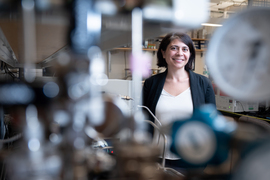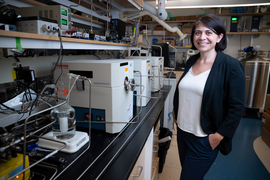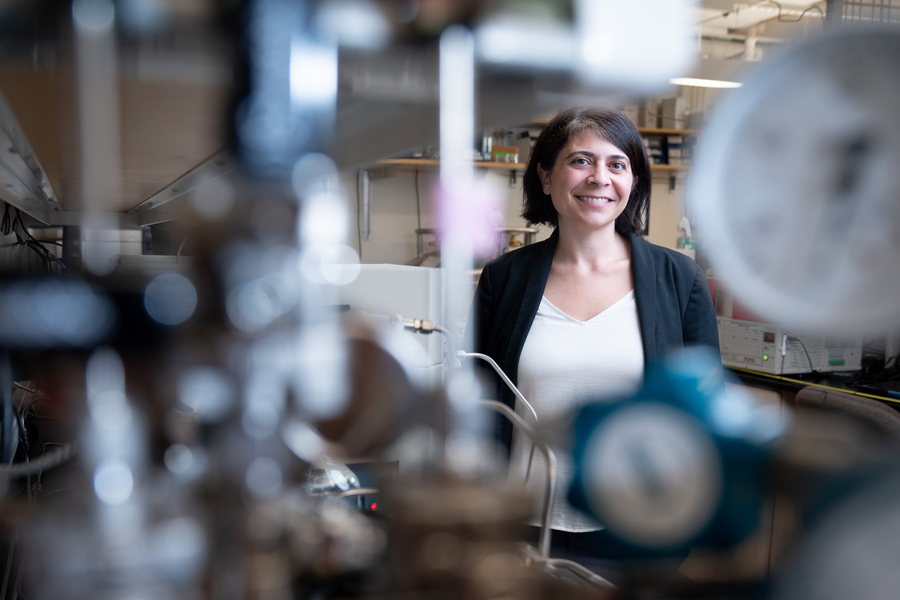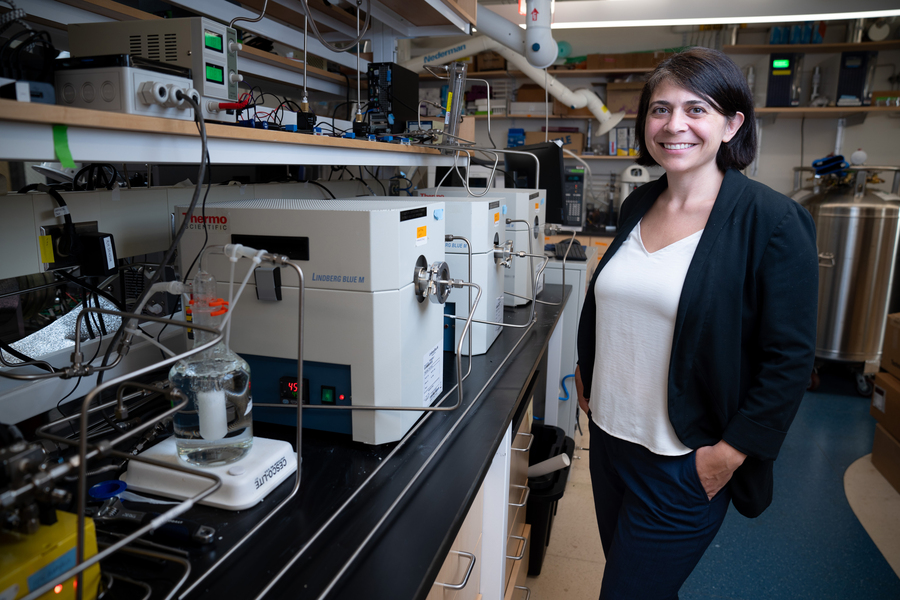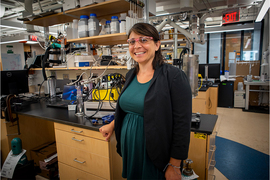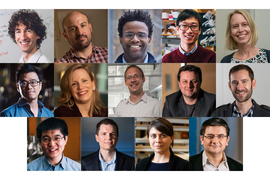In a recent podcast interview with MIT President Sally Kornbluth, Associate Professor Desirée Plata described her childhood pastime of roaming the backyards and businesses of her grandmother’s hometown of Gray, Maine. Through her wanderings, Plata noticed a disturbing pattern.
“I was 7 or 8 when I caught wind of all the illness,” Plata recalls. “It seemed like in every other house there was somebody who had a neurological disorder or a cancer of some sort.”
While driving home one night with her mom, Plata made her first environmental hypothesis from the back seat. “I told my mom, ‘I think there’s something in the water or air where these people live.’”
The conversation happened in the late 1980s. Plata was a little older when she learned her intuition was correct: The Environmental Protection Agency determined that a waste disposal facility had contaminated drinking water in the area while processing more than 1 million gallons of waste between 1965 and 1978.
“There was a New York Times article on it, but it was sort of buried in a Sunday paper and a lot of folks up in Maine didn’t hear about it,” Plata says.
What most struck Plata was that Gray was a tight-knit community, and the people who owned the waste disposal facility were friends with everybody. Eventually, some of the owner’s children even got sick.
“People don’t poison their neighbors on purpose,” Plata says. “A lot of industrial contamination happens either by accident or because the engineers don’t know better. As an environmental scientist and engineer, it’s part of my job to help industrial engineers of any variety design their systems and processes such that they are thinking about what’s going into the environment from the start.”
The insight led Plata to MIT, first as a PhD student, then as a visiting professor, and today as the newly tenured associate professor of civil and environmental engineering.
These days Plata’s work is a bit more complex than her early backseat musings. In fact, her efforts extend far beyond research and include mentoring students, entrepreneurship, coalition-building, and coordination across industry, academia, and government. But the work can still be traced back to the childhood insight that environmental optimization needs to be a more tangible and important part of everyone’s thinking.
“People think sustainability is this nebulous thing they can’t get their hands around,” Plata says. “But there are actually a set of rigorous principles you can use, and each one of those has a metric or a thing you can measure to go with it. MIT is such an innovative place. If we can incorporate environmental objectives into design at a place like MIT, the hope is the world can engage as well.”
Taking the plunge
Plata was first introduced to environmental research in high school, but it wasn’t until she attended Union College and got to work in a research lab that she knew it was what she’d do for the rest of her life.
After graduating from Union, Plata decided to skip a master’s degree and “take the plunge” into the MIT-Woods Hole Oceanographic Institution (WHOI) joint doctoral program.
“Talk about drinking from a firehose,” Plata says. “Everybody you bump into knows something that can help you solve the very hard problem you’re working on.”
Plata began the program studying oil spills, and a paper she co-authored helped spur a law that changed the way oil is transported off the coast of Massachusetts. But developments in her personal life made her want to prevent environmental disasters before they happen.
In her last year at Union, Plata’s aunt was diagnosed with breast cancer — a disease that’s been linked to one of the chemicals dumped in Gray, Maine. While Plata was at MIT, her aunt was receiving treatment at Massachusetts General Hospital down the road, so Plata would work at the lab at night, stay with her aunt during treatments all day, and go home with her on the weekends.
“As I’m sampling oil, I’m recognizing that nothing I’m doing is going to help women like her escape the illness,” Plata recalls.
In her third year of the MIT-WHOI program, Plata shifted her research to explore how industrial emissions generated during the creation of materials known as carbon nanotubes could inform how those valuable new materials were forming. The work led to a dramatically more sustainable way to make the materials, which are needed for important environmental applications themselves.
After earning her PhD, Plata served as a visiting professor at MIT for two years before working in faculty positions at Duke University and Yale University, where she studied green chemistry and green optimization. She returned to MIT as an assistant professor in civil and environmental engineering in 2018.
Working beyond academia
While at Yale, Plata started a company, Nth Cycle, which uses electric currents to extract critical minerals like cobalt and nickel from lithium-ion batteries and other electronic waste. The company began commercial production last year.
Plata also works extensively with government and industry, serving on a Massachusetts committee that published a roadmap to decarbonizing the state by 2050 and advising companies both formally and informally. (She estimates she gets a call every two weeks from a new company working on a sustainability problem.)
“It’s undeniable that industry has an enormous impact on the environment,” Plata says. “Some like to think the government can wave a magic wand and make some regulation and we won’t be in this situation, but that’s not the case. There are technical challenges that need to be solved and businesses play an incredibly important role as agents of change.”
Plata’s research at MIT, meanwhile, is focused increasingly on methane. Last year she helped create the MIT Methane Network, which she directs.
Plata’s research has explored ways to convert methane into less harmful carbon dioxide and other fuels in places like dairy farms and coal plants. This past summer she took a team of students to dairy barns to conduct field tests.
“If you could take methane from coal mining out of the air globally, it’s equivalent to taking all of the combustion engine vehicles off the road, even accounting for the small generation of CO2 that we have [as the result of our process],” Plata says. “If you can fix the problem at dairy farms, it’s like all the combustion engine vehicle emissions times three. It’s a hugely impactful number.”
Taking action
When Plata was in fourth grade, her teacher had students pick up trash around a nearby bay. She’s since done the exercise with other fourth graders.
“You ask them what they think they’ll find, and they say, ‘Nothing. I didn’t see any trash on the way to school today,’ but when you ask them to look, everybody fills their bag by the end of the trip, and you start to realize how much fugitive emissions of waste exists, and then you start to start thinking about all of the chemical contamination that you can’t see,” Plata says.
One of Plata’s chief research goals can be summed up with that exercise: getting people to appreciate the importance of environmental criteria and motivating them to take action.
“Today, I see people looking for these silver bullet solutions to solve environmental problems,” Plata says. “That’s not how we got into this mess, and it’s not how we’re going to get out of it. The problem is really distributed, so what we really need is the sum of a lot of small actions to change the system.”
